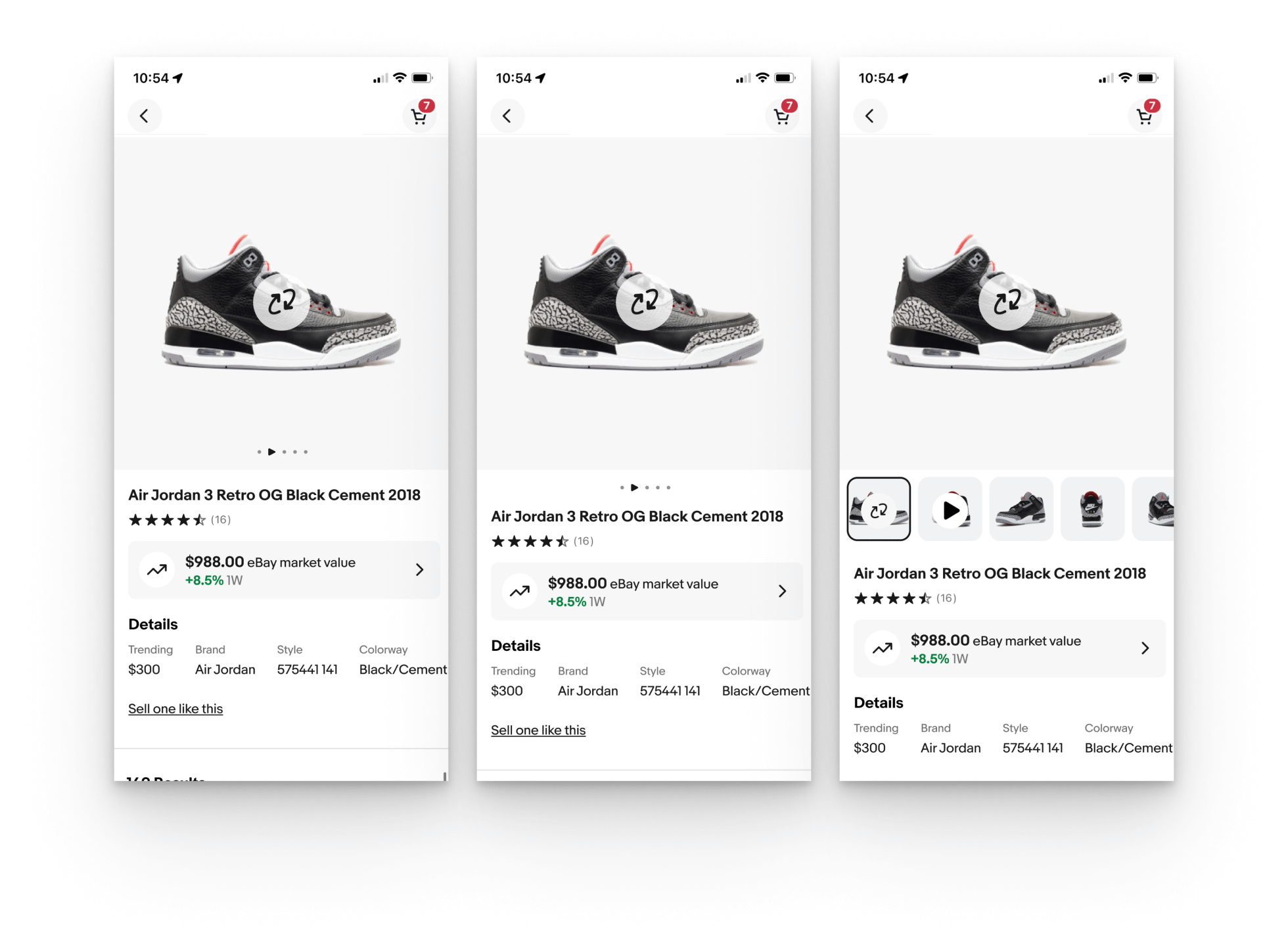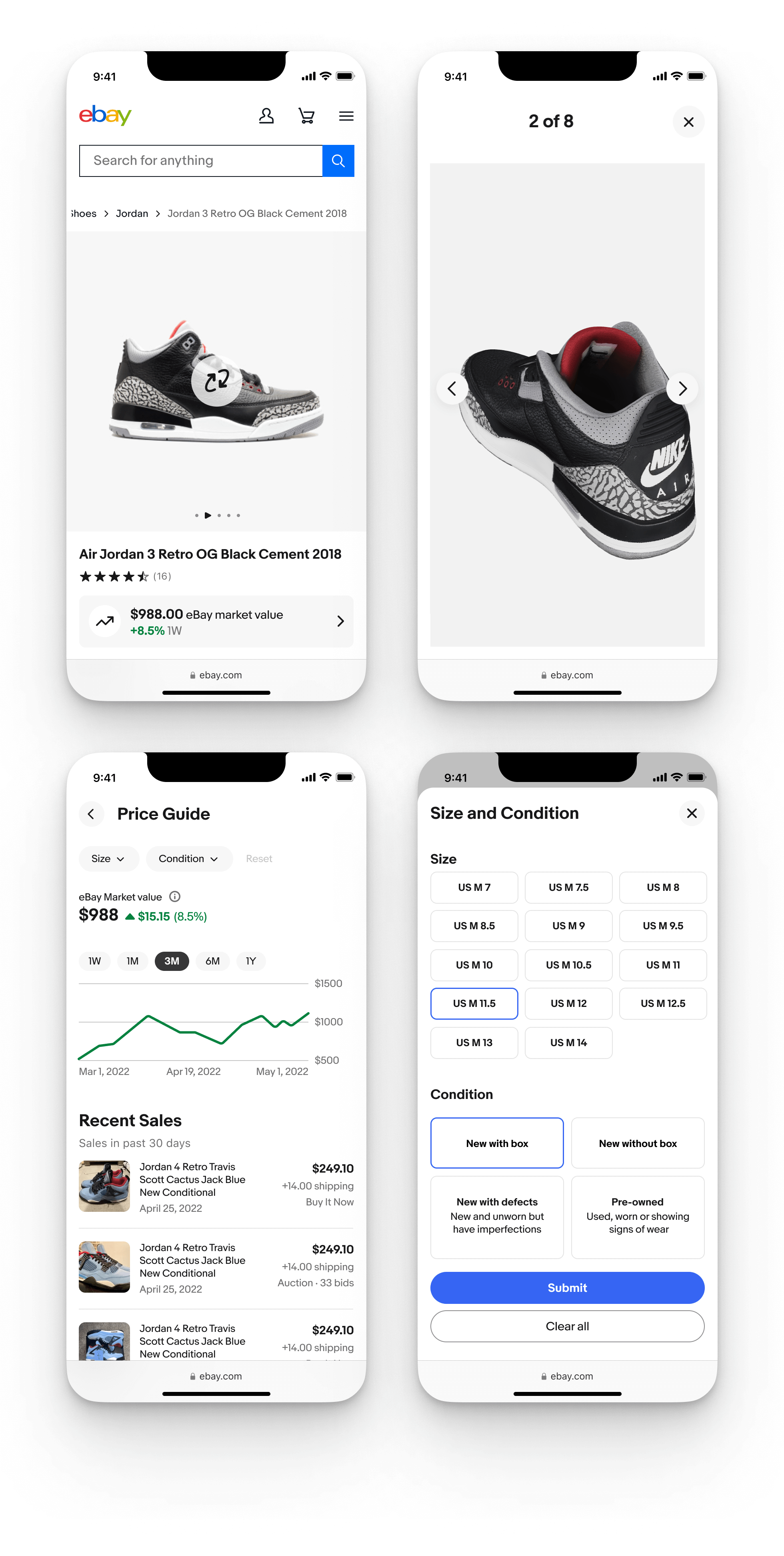One contributing factor to eBay's successful sustainability growth lies in its ongoing commitment to enhancing the website experience. As part of this endeavor, I had the opportunity to work on a project focused on optimizing the browsing experience, specifically tailored to cater to sneakerheads customers.
Context
In the dynamic landscape of sustainable growth and user-centric e-commerce, eBay has consistently demonstrated its commitment to innovation. A prime illustration of this commitment is found in the Model Level Experience initiative, launched in March 2021 and spearheaded by the Browse & SEO teams. The results of this initiative have been remarkable, reshaping key performance metrics in a substantial manner: twice more conversion and nearly 25% of reduction in bounce rate.
Knowing how much a particular sneaker model is sold or listed for is critical throughout sneaker buyers’ shopping journey. A recent user study indicates that sneakerheads spend the majority of their shopping time consuming price related data before making a purchase decision, and they need constant reassurance to make sure they’re buying the right shoes at the right price.
Goals
Our hypothesis was that by refining the current model page with the following features, we could increase conversion rates and reduce bouncing rates of a sneakers model pages:
- High quality and detail media (including 3D view);
- Price guidance information including market value, price history, stats and recent sales;
- Item description and trust signals.
Limitations
We ensured that these media and information elements were readily accessible and prominently displayed above the fold. This approach guaranteed that the content below the hero section remained easily discoverable for users.
The Team
I worked on this project as part of Browse & SEO team, which included another product designer, a PM and 2 engineers.

Process
The Model Page
Functioning as a distinct addition to the regular browsing journey, the Model Page serves as an access point not only within eBay's internal navigation structure but also as an entryway through external search engines, such as Google. Sneakers was the first category that experienced the model level page, underscoring eBay's strategic pursuit to offer users a comprehensive understanding of specific product models. This augmentation aimed to enable users to evaluate, compare, and confidently make purchasing decisions.

Personas
Based on the previous research, we decide to design for two distinct sneaker consumer segments:
- Collectors: Distinguished by their emotional connections to sneaker acquisitions, Collectors seek more than transactions—they forge profound affiliations with their purchases.
- Flippers: Driven by profit, Flippers approach sneaker transactions strategically, employing astute buying and selling practices to achieve financial gains.
User Needs
Detailed research efforts unveiled the primary user requisites within both Collector and Flipper personas:
- Swift Access to Information: Users demanded quick access to essential model information, such as historical pricing trends and prevailing market valuations, crucial for informed decision-making.
- Efficient Model Evaluation: Users sought streamlined means to simultaneously assess individual or multiple models, facilitated by integrated multimedia resources to enrich the evaluative process.
Strategies
Conducted a thorough comparison between StockX and GOAT, prominent players in the market. This analysis aimed to extract insights into their features, functionalities, and user journeys, revealing our competitive advantages and drawbacks.
Executed a Group Diary Journal capturing the end-to-end process of purchasing sneakers from one competitor. This documentation encompassed every step, providing insights into the distinctive attributes that make each competitor stand out. We could capture the journey highlights and pain points and create a report with specific thoughts and screens that impacted our sneaker browsing and purchasing experience.
Based on this findings, I began to design by iterating on the current sneakers model page.
UI Design
Media carousel exploration on mobile

Image Details and Price Guidance on mobile

Media carousel exploration on desktop

Validation
Throughout the entirety of the process, we facilitated multiple design critique sessions. These sessions were inclusive of the design system team, allowing for a comprehensive refinement of the proposed solution.
We supported the research team on usability tests conduction. Following these interactions, we were primed for the handoff to development. This presented an excellent opportunity for us to collaborate closely with engineers, ensuring the seamless delivery of a polished interface.
Subsequent to a design quality review of the newly developed pages, we attained the readiness to initiate the experience's launch. This was followed by an A/B testing within a production environment.
Results
The project's initial outcomes are looking promising, even though the exact metrics can't be shared. We've observed a boost in user engagement, especially with the media carousel and the 3D view feature. These early signs suggest that the project is on the right track and has the potential to enhance user interaction and satisfaction.
You can check the sneakers Model Page here.
Next Steps
Phase 1 of implementation is done and research will be collecting data in the following quarter. We expect to keep refining the experience as we expand to new verticals like and Rolex and Part & Accessories. In the meanwhile we will be diving into the next two phases of implementation: price guidance and adding model description to the hero.

Comments are closed.